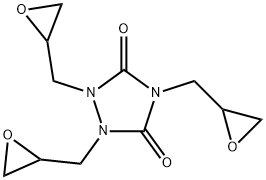anaxirone
- CAS NO.:77658-97-0
- Empirical Formula: C11H15N3O5
- Molecular Weight: 269.25
- MDL number: MFCD00866473
- EINECS: 278-745-8
- SAFETY DATA SHEET (SDS)
- Update Date: 2024-10-23 13:36:13

What is anaxirone?
Originator
Anaxirone, Onbio Inc.
The Uses of anaxirone
Triglycidylurazole is a drug shown to reduce tumor-induced bone destruction in the rat.
Manufacturing Process
In a 4-liter three-necked flask equipped with a stirrer, thermometer and reflux condenser, 101 g (1 mole) of triazolidine-3,5-dione, 2775 g (30 moles) of epichlorohydrin and 2 ml of triethylamine are heated to 80°C by means of an oil bath. The mixture reacts exothermically so that the oil bath may be removed. After the exothermic reaction has abated, the reaction mixture is stirred at 80°C. The total reaction time is 10 hours. 250 g of 50% sodium hydroxide solution are added dropwise to the solution obtained over a period of 4 hours at from 30 to 40°C in such a way that the water added and the water formed during the reaction is continuously removed by azeotropic distillation at from 30 to 60 Torr using a water separator. To complete the reaction, the reaction mixture is stirred for another hour and the sodium chloride formed is separated by filtration. The sodium chloride is washed twice with 200 g of epichlorohydrin and the combined epichlorohydrin solutions are washed with 200 ml of water. After the organic phase has been dried over sodium sulfate, the solvent is removed by concentration in a rotary evaporator and the residue is dried, ultimately at 80°C/0.2 mbar, to constant weight. 240 g of a light brown viscous oil are obtained. It was found to have an epoxide value of 0.93 and has a chlorine content of 2.75%. The viscous oil crystallizes after standing for from a few hours to days. The practically pure 1,2,4- triglycidyl triazolidine-3,5-dione melting at from 98° to 103°C crystallizes by dissolution in methanol and cooling to 5°C. IR- and NMR-spectra in conjunction with elemental analysis and epoxide determination confirm the assumed structure. Melting point 94-96°C.
Therapeutic Function
Antineoplastic
Properties of anaxirone
| Melting point: | 91°C |
| Boiling point: | 412.4°C (rough estimate) |
| Density | 1.2986 (rough estimate) |
| refractive index | 1.4930 (estimate) |
| pka | -1.72±0.20(Predicted) |
| Water Solubility | 0.2g/L(temperature not stated) |
Safety information for anaxirone
Computed Descriptors for anaxirone
New Products
(S)-3-Aminobutanenitrile hydrochloride 4-Methylphenylacetic acid N-Boc-D-alaninol N-BOC-D/L-ALANINOL Tert-butyl bis(2-chloroethyl)carbamate 3-Morpholino-1-(4-nitrophenyl)-5,6-dihydropyridin- 2(1H)-one Furan-2,5-Dicarboxylic Acid Tropic acid 1-Bromo-3,5-Di-Tert-Butylbenzene S-2-CHLORO PROPIONIC ACID ETHYL ISOCYANOACETATE 2-Bromo-1,3-Bis(Dimethylamino)Trimethinium Hexafluorophosphate 4-IODO BENZOIC ACID 3-NITRO-2-METHYL ANILINE 1-(2,4-DICHLOROPHENYL) ETHANAMINE (2-Hydroxyphenyl)acetonitrile 4-Bromopyrazole 2-(Cyanocyclohexyl)acetic acid 4-methoxy-3,5-dinitropyridine 1-(4-(aminomethyl)benzyl)urea hydrochloride 2-aminopropyl benzoate hydrochloride diethyl 2-(2-((tertbutoxycarbonyl)amino) ethyl)malonate tert-butyl 4- (ureidomethyl)benzylcarbamate Ethyl-2-chloro((4-methoxyphenyl)hydrazono)acetateRelated products of tetrahydrofuran






You may like
-
 2033-24-1 98%View Details
2033-24-1 98%View Details
2033-24-1 -
 42831-50-5 5-METHYLISOXAZOLE-4-CARBOXYLIC ACID 98%View Details
42831-50-5 5-METHYLISOXAZOLE-4-CARBOXYLIC ACID 98%View Details
42831-50-5 -
 1975-50-4 98%View Details
1975-50-4 98%View Details
1975-50-4 -
 2-HYDROXY BENZYL ALCOHOL 98%View Details
2-HYDROXY BENZYL ALCOHOL 98%View Details
90-01-7 -
 2-Chloro-1,3-Bis(Dimethylamino)Trimethinium Hexafluorophosphate 221615-75-4 98%View Details
2-Chloro-1,3-Bis(Dimethylamino)Trimethinium Hexafluorophosphate 221615-75-4 98%View Details
221615-75-4 -
 61397-56-6 CIS BROMO BENZOATE 98%View Details
61397-56-6 CIS BROMO BENZOATE 98%View Details
61397-56-6 -
 14714-50-2 (2-Hydroxyphenyl)acetonitrile 98+View Details
14714-50-2 (2-Hydroxyphenyl)acetonitrile 98+View Details
14714-50-2 -
 118753-70-1 98+View Details
118753-70-1 98+View Details
118753-70-1